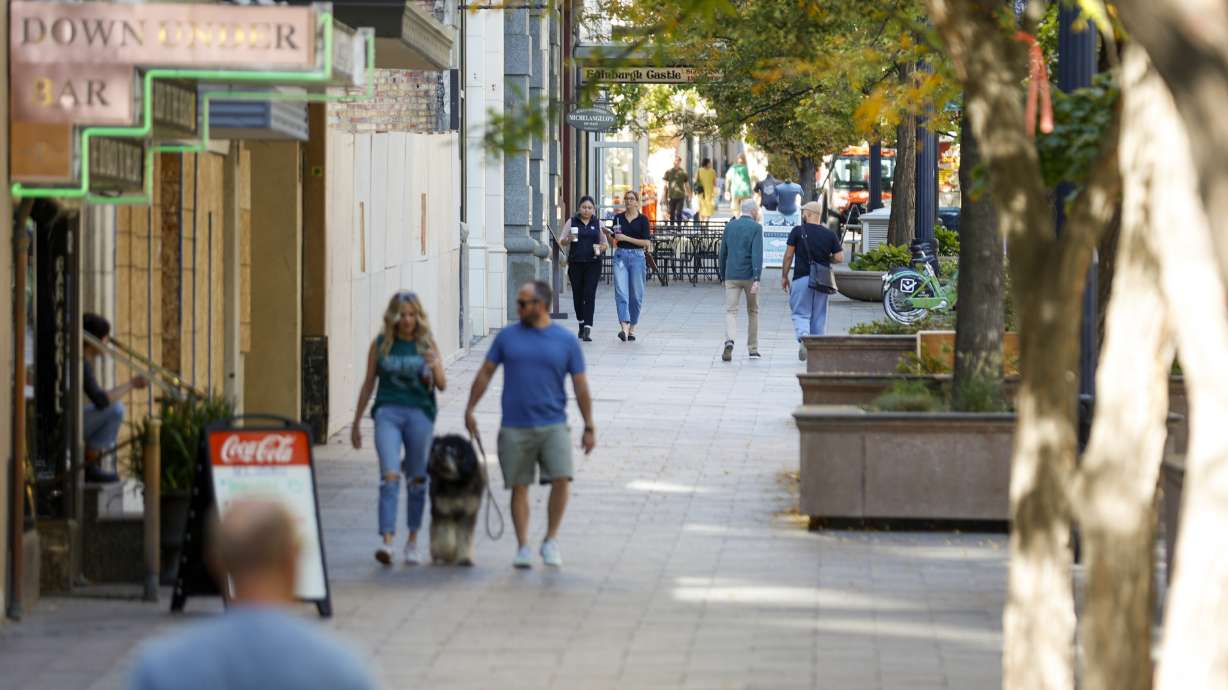Estimated read time: 5-6 minutes
This archived news story is available only for your personal, non-commercial use. Information in the story may be outdated or superseded by additional information. Reading or replaying the story in its archived form does not constitute a republication of the story.
SALT LAKE CITY — Visits to downtown Salt Lake City are slowly inching closer to pre-COVID-19 pandemic levels, but it appears the reasons people are coming to the city's core have changed in the past three years.
Leaders of the Salt Lake City Downtown Alliance and Salt Lake City Cultural Core on Tuesday provided an update to the Salt Lake City Council on trends and future plans. Dee Brewer, executive director of the Salt Lake City Downtown Alliance, acknowledged that downtown's economic drivers have flipped — at least for now.
"Our downtown economy is transitioning," he said. "The social economy is growing ... and new office worker patterns are driving changes."
A new driver in downtown activity
Offices strongly bolstered the downtown Salt Lake City economy until the COVID-19 pandemic prompted lockdowns in March 2020, and many employers opted for remote work as a safety precaution. It's been a slow recovery since.
Office worker stays lasting more than 45 minutes in downtown Salt Lake peaked at about 60,000 people from March 28 to Sept. 19, according to Salt Lake City Downtown Alliance presented Tuesday. That's down significantly when compared to data from a similar stretch of time in 2019.

Worker occupancy generally brought about 100,000 people during the spring and summer of 2019, including peaks that fell just shy of 120,000 people. Ultimately, worker occupancy has only recovered to about 54% of September 2019 volumes.
"We've got about half of the office workers on any given day than we did three years ago," Brewer said. "It used to be that our downtown economy was very much driven by the presence of those office workers."
Conversely, social economy stays — visits to restaurants, bars and other activities in the downtown area — are faring much better. This statistic remained close to the 2019 figures over the summer, even peaking at nearly 400,000 people on Sept. 19, about the same as a pair of event spikes during the summer of 2019.

City visitors are now back to 82% of pre-pandemic levels in September 2019.
"Visitation in the nighttime economy is really driving the economic return of downtown," Brewer said, later adding that volumes at downtown restaurants and bars are now "on par" with levels in 2019.
The social economy is expected to grow even more as business conventions return to pre-pandemic levels. The Outdoor Retailer trade show returns to Salt Lake City next year, while Salt Lake City is also the host of the 2023 NBA All-Star Game. Both highlight the types of major attractions that will likely drive downtown visitation.
But there have been plenty of arts, entertainment and business options that have helped contribute to a surge in the social economy, as well. For instance, the Downtown Alliance notes that response to recent events show that attendees are coming from all over the region, not just other parts of the city.
The BLOCKS, a brand of Salt Lake City's Cultural Core, aims to promote downtown cultural and arts events and programs in the city. These include musical events in public areas downtown and the winter art installations at Gallivan Plaza.
The Salt Lake City Downtown Alliance sponsors other events, such as the Salt Lake City Downtown Farmers Market and Open Streets. Market organizers said spending at the market this year rose 20% compared to 2019, while Open Streets — where Main Street is closed to motor vehicle traffic — originated from the demand for open space at the heart of the COVID-19 pandemic.
Combined, the two groups are generating new incentives for people to visit the city's downtown area.
"(It) has brought so much to our city in terms of vitality, community and also incredible economic development opportunity, especially through a very difficult time, which has been recovery," said Lorena Riffo-Jenson, the director of the Salt Lake City Department of Economic Development.
How long will the trend last?
It's worth noting that this phenomenon is also appearing in other cities. However, Brewer says he doesn't know if this is a short-term or permanent shift in how people end up in downtown Salt Lake City.
The city's central business district is becoming more residential, which, he said, will likely continue to drive social economy visitation. The downtown core is still on track to double in the next three years, as more apartment complexes and high-rises are completed.
There are even a pair of projects aimed at converting old Salt Lake office spaces into housing in the works. Those are the South Temple Tower and the old CenturyLink data center on 200 South.
"I think you'll see more Class B office space being transformed into residential (space)," Brewer said. "Class A office space is doing OK. But Class B is what has really suffered."
Given the relatively stable demand for newly built and desirable Class A office space, Brewer adds that he believes there will be some sort of "natural evolution" that will result in at least some work going into traditional office spaces. That said, he admits it's an economic aspect really out of the Downtown Alliance's control.
"I think for a young worker in an office, if they are ambitious and looking to grow, being present is going to matter," he said. "I think that's going to drive greater participation in the office. That's not something that our team has levers to pull."










